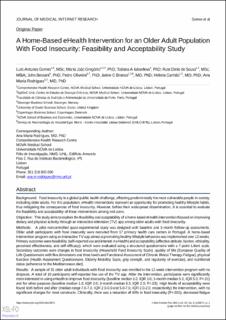| dc.contributor.author | Gomes, L A | |
| dc.contributor.author | Gregorio, M J | |
| dc.contributor.author | Iakovleva, Tatiana Aleksandrovna | |
| dc.contributor.author | se Sousa, R D | |
| dc.contributor.author | Bessant, John Robert | |
| dc.contributor.author | Oliveira, P | |
| dc.contributor.author | Branco, J C | |
| dc.contributor.author | Canhão, Helena | |
| dc.contributor.author | Rodrigues, A M | |
| dc.date.accessioned | 2022-01-31T13:25:34Z | |
| dc.date.available | 2022-01-31T13:25:34Z | |
| dc.date.created | 2022-01-26T14:08:06Z | |
| dc.date.issued | 2021-08 | |
| dc.identifier.citation | Gomes, L A., Gregorio, M.J., Iakovleva, T.A., se Sousa, R D., Bessant, J.R., Oliveira, P., Branco, J.C., Canhão, H. (2021) A Home-Based eHealth Intervention for an Older Adult Population With Food Insecurity: Feasibility and Acceptability Study. Journal of Medical Internet Research, 23(8) | en_US |
| dc.identifier.issn | 1438-8871 | |
| dc.identifier.uri | https://hdl.handle.net/11250/2976031 | |
| dc.description.abstract | Background: Food insecurity is a global public health challenge, affecting predominately the most vulnerable people in society, including older adults. For this population, eHealth interventions represent an opportunity for promoting healthy lifestyle habits, thus mitigating the consequences of food insecurity. However, before their widespread dissemination, it is essential to evaluate the feasibility and acceptability of these interventions among end users. Objective: This study aims to explore the feasibility and acceptability of a home-based eHealth intervention focused on improving dietary and physical activity through an interactive television (TV) app among older adults with food insecurity. Methods: A pilot noncontrolled quasi-experimental study was designed with baseline and 3-month follow-up assessments. Older adult participants with food insecurity were recruited from 17 primary health care centers in Portugal. A home-based intervention program using an interactive TV app aimed at promoting healthy lifestyle behaviors was implemented over 12 weeks. Primary outcomes were feasibility (self-reported use and interest in eHealth) and acceptability (affective attitude, burden, ethicality, perceived effectiveness, and self-efficacy), which were evaluated using a structured questionnaire with a 7-point Likert scale. Secondary outcomes were changes in food insecurity (Household Food Insecurity Scale), quality of life (European Quality of Life Questionnaire with five dimensions and three levels and Functional Assessment of Chronic Illness Therapy-Fatigue), physical function (Health Assessment Questionnaire, Elderly Mobility Scale, grip strength, and regularity of exercise), and nutritional status (adherence to the Mediterranean diet). Results: A sample of 31 older adult individuals with food insecurity was enrolled in the 12-week intervention program with no dropouts. A total of 10 participants self-reported low use of the TV app. After the intervention, participants were significantly more interested in using eHealth to improve food insecurity (baseline median 1.0, IQR 3.0; 3-month median 5.0, IQR 5.0; P=.01) and for other purposes (baseline median 1.0, IQR 2.0; 3-month median 6.0, IQR 2.0; P=.03). High levels of acceptability were found both before and after (median range 7.0-7.0, IQR 2.0-0.0 and 5.0-7.0, IQR 2.0-2.0, respectively) the intervention, with no significant changes for most constructs. Clinically, there was a reduction of 40% in food insecurity (P=.001), decreased fatigue (mean −3.82, SD 8.27; P=.02), and improved physical function (Health Assessment Questionnaire: mean −0.22, SD 0.38; P=.01; Elderly Mobility Scale: mean −1.50, SD 1.08; P=.01; regularity of exercise: baseline 10/31, 32%; 3 months 18/31, 58%; P=.02). No differences were found for the European Quality of Life Questionnaire with five dimensions and three levels, grip strength, or adherence to the Mediterranean diet. Conclusions: The home-based eHealth intervention was feasible and highly acceptable by participants, thus supporting a future full-scale trial. The intervention program not only reduced the proportion of older adults with food insecurity but also improved participants’ fatigue and physical function. | en_US |
| dc.language.iso | eng | en_US |
| dc.publisher | JMIR Publications | en_US |
| dc.rights | Navngivelse 4.0 Internasjonal | * |
| dc.rights.uri | http://creativecommons.org/licenses/by/4.0/deed.no | * |
| dc.subject | e-helse | en_US |
| dc.subject | eldre | en_US |
| dc.title | A Home-Based eHealth Intervention for an Older Adult Population With Food Insecurity: Feasibility and Acceptability Study | en_US |
| dc.type | Peer reviewed | en_US |
| dc.type | Journal article | en_US |
| dc.description.version | publishedVersion | en_US |
| dc.rights.holder | ©Luís Antunes Gomes, Maria João Gregório, Tatiana A Iakovleva, Rute Dinis de Sousa, John Bessant, Pedro Oliveira, Jaime C Branco, Helena Canhão, Ana Maria Rodrigues. | en_US |
| dc.subject.nsi | VDP::Medisinske Fag: 700 | en_US |
| dc.source.volume | 23 | en_US |
| dc.source.journal | Journal of Medical Internet Research | en_US |
| dc.source.issue | 8 | en_US |
| dc.identifier.doi | 10.2196/26871 | |
| dc.identifier.cristin | 1990518 | |
| dc.relation.project | Norges forskningsråd: 299192 | en_US |
| cristin.ispublished | true | |
| cristin.fulltext | original | |
| cristin.qualitycode | 2 | |

